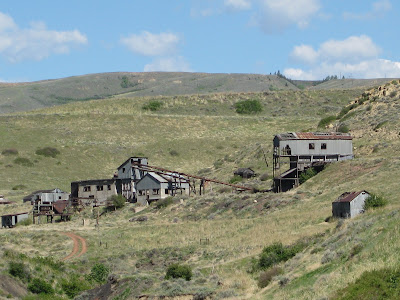Our Red Lodge hosts, Lynette and Merv, treated us to a homemade eggs, cheese and sausage rolled tortilla casserole that was out of this world! After a last minute online check on their computer in the faint hope that the Beartooth Scenic Highway was open (of course it wasn’t), we headed out on MT-SR 78, to see some of the ranch country near the tiny hamlet of Roscoe. Believe it or not, we first heard about this scenic area from a fellow we met at the Pahrump Valley Winery (click “Postcard from Tonopah, NV”).
We drove back through Red Lodge to a viewpoint just below the closure on the Beartooth Highway, to take a close-up photo of the Beartooth Mountains, then began our trek east.
First was a stop to see the ghost town of Washoe. This was a coal-mining town that suffered a calamity in February 1943 when an underground explosion took 74 lives. Very little remains today.
We continued to Lovell, WY for a grocery and gas stop, then embarked on the Medicine Wheel Passage/Bighorn Scenic Byway (US 14 Alt/US 14). The highest reaches of this challenging road were nearly 10,000 feet in altitude. Although the road had been plowed, the rolling plateau and adjacent slopes were still covered with considerable snow. There was even snowmobile activity this far into June!
We enjoyed a picnic amid the snow banks, warmed by a benevolent sun, then began the long descent to the Little Bighorn Battlefield National Monument. According to the National Park Service's narrative:
“Little Bighorn Battlefield National Monument near Crow Agency, Montana, commemorates one of America's most significant and famous battles, the Battle of the Little Bighorn. Here on June 25 and 26, 1876, two divergent cultures clashed in a life or death struggle.
“Four hundred years of struggle between Euro-Americans and Native Americans culminated on this ground. Like a handful of battles in American history, the defeat of 12 companies of Seventh Cavalry by Lakota (Sioux), Cheyenne, and Arapaho warriors rose beyond its military significance to the level of myth. Thousands of books, magazine articles, performances in film and theater, paintings, and other artistic expressions have memorialized ‘Custer's Last Stand’.
“In 1879, the Little Bighorn Battlefield was designated a national cemetery administered by the War Department. In 1881, a memorial was erected on Last Stand Hill, over the mass grave of the Seventh Cavalry soldiers, U.S. Indian Scouts, and other personnel killed in battle. In 1940, jurisdiction of the battlefield was transferred to the National Park Service. These early interpretations were largely mono-cultural, honoring only the U.S. Army's perspective, with headstones marking where each fell.
“The essential irony of the Battle of the Little Bighorn is that the victors lost their nomadic way of life after their victory. Unlike Custer's command, the fallen Lakota and Cheyenne warriors were removed by their families, and ‘buried’ in the Native American tradition, in teepees or tree-scaffolds nearby in the Little Bighorn Valley. The story of the battle from the Native American perspective was largely told through the oral tradition.
“Even so, today, no memorial honors the Native Americans who struggled to preserve and defend their homeland and traditional way of life. Their heroic sacrifice was never formally recognized - until now.
“In 1991, the U. S. Congress changed the name of the battlefield and ordered the construction of an Indian Memorial. In 1996, the National Park Service - guided by the Little Bighorn Battlefield National Monument Advisory Committee, made up of members from the Indian nations involved in the battle, historians, artists and landscape architects - conducted a national design competition. In 1997 a winning design was selected.”
 7th Cavalry Monument, Little Bighorn Battlefield
7th Cavalry Monument, Little Bighorn BattlefieldNational Monument. The monument contains a list of
the U.S. soldiers killed in Custer's Last Stand.

Wild Horses at Little Bighorn Battlefield.
After our visit to the Battlefield, we stopped at the Big Horn County Historical Museum and State Visitor Center, then continued to downtown Billings. With a population of about 90,000, Billings is the largest city in Montana. People were enjoying happy hour in sidewalk cafés on this balmy late afternoon.
Billings is a vibrant city with an eclectic blend of the old and new. There are worthwhile attractions, including the Moss Mansion, and Montana Fun Adventure Tours offers walking tours of the downtown historic district.
Another private home, a townhouse located in newer northwest Billings, served as our overnight accommodation. Doris offered us a glass of wine and recommended a nearby Italian restaurant, Carinos Grill, for dinner. Although it was a chain restaurant, we both thought their baked lasagna at $11 was tasty and an excellent value. After a pleasant evening of conversation with our hostess, we turned in.







No comments:
Post a Comment